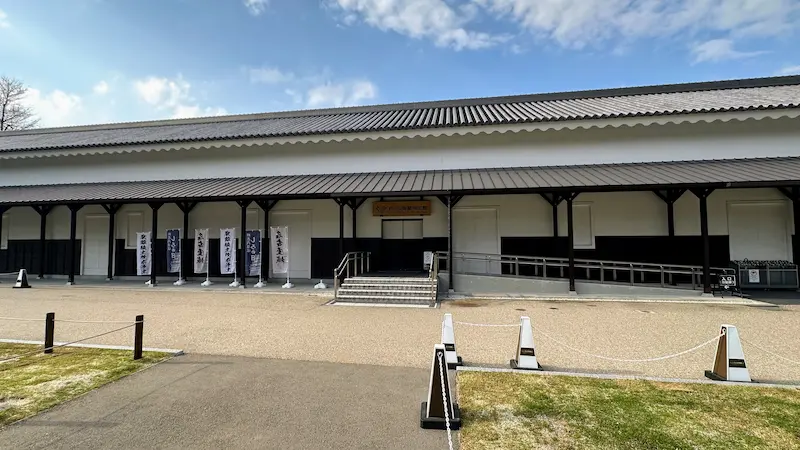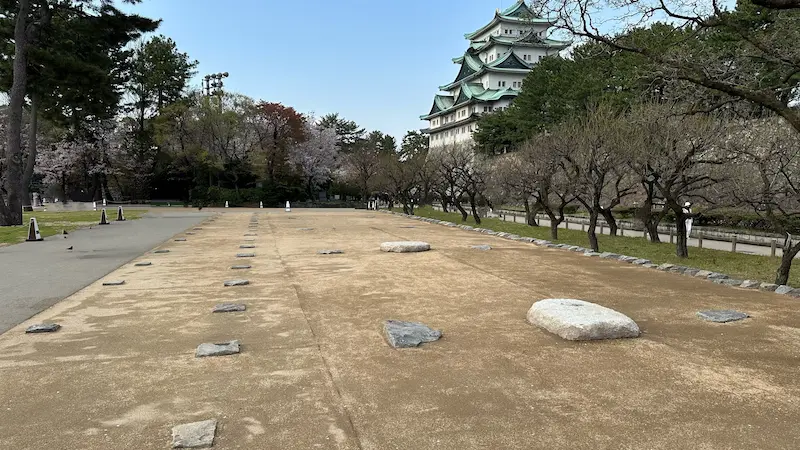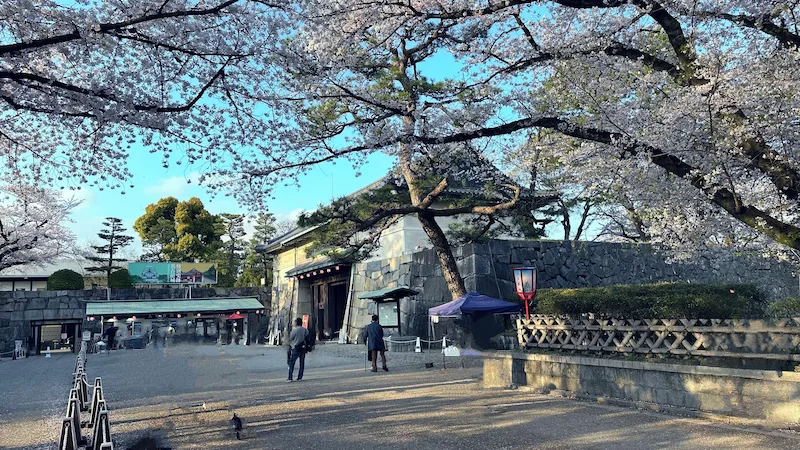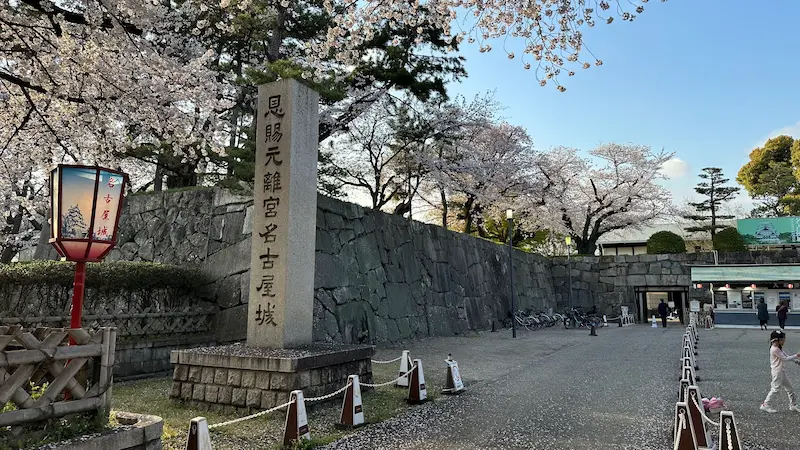Museum, Ancient Trees, and Historical Gateways — Immersing Yourself in the Cultural Layers of Nagoya Castle’s Nishi-no-Maru Area
The Nishi-no-Maru (West Bailey) area of Nagoya Castle is a unique cultural enclave where nature, architecture, and heritage seamlessly converge. This historically rich section of the castle grounds is home to landmarks such as the Nishi-no-Maru Okura Shōhōkan—a museum housed in a reconstructed Edo-period rice storehouse—as well as the majestic Kaya Tree, more than 600 years old, and a variety of imperial and feudal relics, including the castle’s Main Gate and the imperial Stone Marker. Each of these highlights offers a distinct way to experience the multifaceted legacy of Nagoya Castle.
Nishi-no-Maru Okura Shōhōkan (West Bailey Storehouse Museum)

🏛 Overview
Located within the Nishi-no-Maru area, the Nishi-no-Maru Okura Shōhōkan is a museum and archive built to replicate the exterior of two Edo-period rice storehouses, Sanban-gura and Yonban-gura. The facility houses invaluable historical materials and cultural assets from the castle’s collection, offering an in-depth look at Nagoya Castle’s extensive legacy.
Inside, visitors will find a “History Information Room” that tells the story of the castle through interactive exhibits, and a “Gallery Room” featuring rotating displays of important artifacts such as the National Important Cultural Property sliding screen paintings (fusuma-e) from the castle’s main palace. There’s also a gift shop offering Nagoya Castle-themed merchandise, including rice-related goods in a nod to the site’s original function.
One notable past exhibit was “Nagoya Castle Through Masterpieces: Construction, Wartime Destruction, and Future Visions” (March 7–April 20, 2025), which showcased historical treasures including imperial belongings and famous castle artworks.
🗺 Address
1-1 Honmaru, Naka Ward, Nagoya, Aichi Prefecture – Nishi-no-Maru Okura Shōhōkan
🚶 Access
Approx. 7-minute walk (500m) from U no Kubi
⏳ Suggested Visit Duration
- Quick Visit: Approx. 5 minutes (viewing the exterior)
- Full Experience: Approx. 1 hour (including exhibitions and gift shop)
📍 Highlights
- History Information Room: Engaging exhibits using videos and games that trace the history of Nagoya Castle.
- Exhibition Gallery: Rotating displays of valuable cultural properties, including palace wall paintings.
- Museum Shop: Exclusive Nagoya Castle items and products themed around rice and food culture.
📌 Trivia
- Historical Background: The building design faithfully reproduces Edo-era storehouses used to stock the castle’s rice reserves.
- Little-Known Fact: The museum includes kid-friendly explanations and interactive experiences, making it great for families.
- Famous Figures: Some items on display have direct ties to the Tokugawa family, including heirlooms and official artifacts.
Nishi-no-Maru (West Bailey)

🏛 Overview
The Nishi-no-Maru area, situated to the west of the main compound, served a crucial role during the Edo period as both a defensive zone and a logistical hub for food storage. Six rice storehouses (Ichiban-gura to Rokuban-gura) once stood here, forming the castle’s primary granary complex.
After the 1891 Nōbi Earthquake, the area’s gate (Enokida-mon) was severely damaged and later rebuilt, eventually becoming the Main Gate of Nagoya Castle. In 2021, the Nishi-no-Maru area gained new significance with the opening of the Okura Shōhōkan.
🗺 Address
1-1 Honmaru, Naka Ward, Nagoya, Aichi Prefecture – Nishi-no-Maru
🚶 Access
Approx. 3-minute walk (230m) from Okura Shōhōkan
⏳ Suggested Visit Duration
- Quick Visit: Approx. 5 minutes
- Full Tour: Approx. 20 minutes (Note: original mistakenly said 20 hours)
📍 Highlights
- Okura Shōhōkan Museum: Explore a modern cultural facility that showcases the legacy of Edo-period rice storage.
- Main Gate (Former Enokida Gate): Rebuilt in the Meiji period, the gate serves as a dignified entry to the castle.
- Seasonal Beauty: In spring, cherry blossoms bloom along the pathways, making this area a favorite for hanami.
📌 Trivia
- Historical Significance: The storehouses were vital for food security, especially during war and natural disasters.
- Hidden Highlight: The Nishi-no-Maru is also home to a Kaya tree recognized as a Natural Monument.
- Famous Figures: Part of Tokugawa Ieyasu’s strategic fortress design, the area reflects the power of the Owari Tokugawa clan.
The Kaya Tree of Nagoya Castle

🏛 Overview
Standing tall in the Nishi-no-Maru area is the Kaya Tree, a colossal conifer estimated to be over 600 years old. Designated a National Natural Monument in 1932, this tree predates the construction of Nagoya Castle and has borne silent witness to centuries of history.
Miraculously, it survived the 1945 Nagoya air raid that destroyed much of the castle. Legend holds that during the Siege of Osaka, Tokugawa Yoshinao—the first Lord of the Owari Domain—ate fruit from this very tree for good luck, earning it the title “Tree of Victory.”
🗺 Address
1-1 Honmaru, Naka Ward, Nagoya, Aichi Prefecture – Nishi-no-Maru
🚶 Access
Approx. 3-minute walk (20m) from Nishi-no-Maru
⏳ Suggested Visit Duration
- Quick Visit: Approx. 5 minutes
- In-depth Appreciation: Approx. 15 minutes
📍 Highlights
- Majestic Presence: A rare opportunity to view a 600-year-old tree up close.
- Informative Signage: Learn about its botanical and historical significance.
- Seasonal Interest: In autumn, the tree bears fruit, offering a glimpse of nature’s cycles.
📌 Trivia
- Survivor Tree: Despite being damaged in WWII, it stands strong as a symbol of endurance.
- Little-Known Legend: The tree’s seeds were used in ceremonial meals for samurai lords.
- Famous Figures: Tokugawa Yoshinao’s connection imbues the tree with symbolic importance.
Main Gate (Former Enokida Gate)

🏛 Overview
The Main Gate, formerly known as Enokida Gate, was once the principal entrance to Nagoya Castle’s Nishi-no-Maru, reserved for the daimyo and high-ranking retainers. The original gate was destroyed in the 1891 Nōbi Earthquake. In 1910, the Hasuike Gate from Edo Castle was relocated and served as the entrance to the Nagoya Detached Imperial Villa. This gate was later lost in the 1945 bombing and rebuilt in 1959 alongside the castle keep.
🗺 Address
1-1 Honmaru, Naka Ward, Nagoya, Aichi Prefecture – Main Gate
🚶 Access
Approx. 1-minute walk (100m) from the Kaya Tree
⏳ Suggested Visit Duration
- Quick Visit: Approx. 3 minutes
- Full Tour: Approx. 15 minutes
📍 Highlights
- Faithful Reconstruction: Though made of reinforced concrete, the gate mirrors the original timber design.
- Stonework Details: Admire the surrounding stone walls and the craftsmanship of Edo-era masons.
- Seasonal Beauty: Cherry blossoms add a romantic flourish to this historical structure each spring.
📌 Trivia
- Imperial Past: Once served as the main gate to Nagoya’s imperial villa.
- Hidden Craftsmanship: The gate’s modern materials are disguised to resemble traditional woodwork.
- Famous Figures: A legacy of Tokugawa Ieyasu’s fortress vision.
Imperial Stone Marker of Nagoya Castle

🏛 Overview
This stone marker, located near the Main Gate, commemorates the period when Nagoya Castle served as an imperial detached palace (Onshi Moto-Rikyu). It marks the 1930 transfer of the castle from the Imperial Household to Nagoya City.
Originally built under Tokugawa Ieyasu and long held by the Owari Tokugawa family, Nagoya Castle became imperial property during the Meiji era before returning to public hands.
🗺 Address
1-1 Honmaru, Naka Ward, Nagoya, Aichi Prefecture – near Main Gate
🚶 Access
Approx. 1-minute walk (26m) from the Main Gate
⏳ Suggested Visit Duration
- Quick Visit: Approx. 3 minutes
- In-depth Tour: Approx. 15 minutes
📍 Highlights
- Historical Inscription: Read the stone etching that links Nagoya Castle to the Japanese imperial household.
- Contextual Learning: Discover surrounding historical plaques that deepen the story.
- Seasonal Experience: Enjoy the beauty of the monument surrounded by cherry blossoms in spring.
📌 Trivia
- Brief Imperial Tenure: The castle’s time as a detached imperial villa was short but significant.
- Little-Known Detail: Additional monuments and markers nearby provide deeper insight into the site’s evolution.
- Famous Figures: From Tokugawa Ieyasu to the Emperor, this site has served generations of Japan’s elite.



comment